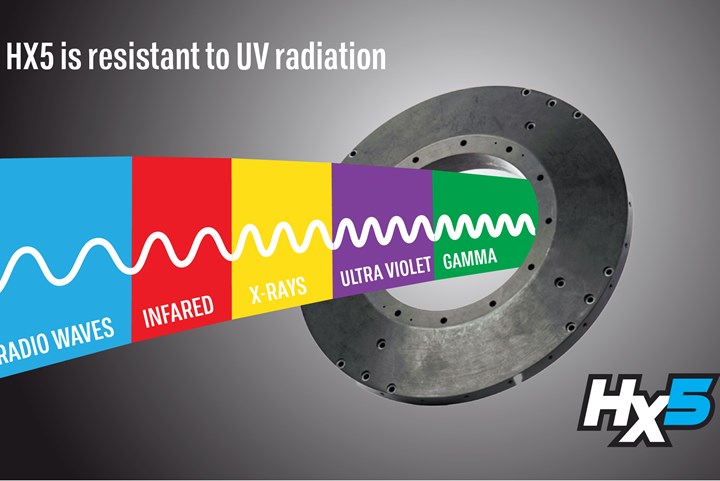Alpine Advanced Materials thermoplastic nanocomposite demonstrates UV resistance
UVA and UVC testing on the aviation-grade thermoplastic nanocomposite, HX5, found no performance degradation or impact on physical appearance.

Photo Credit: Alpine Advanced Materials
Alpine Advanced Materials (Dallas, Texas, U.S.) recently reported that it has added UV resistance to the growing benefits of its flagship HX5 thermoplastic nanocomposite. Based on testing using both UVA and UVC (ultraviolet A and ultraviolet C) exposure, the novel material demonstrated an exceptional resistance to both UV wavelengths with no detrimental effects to either its appearance or mechanical performance.
Due to its high frequencies and large amounts of energy, Alpine says, UV interacts with molecules and can contribute to material degradation. Understanding the effects of UVA exposure are important since it comprises 98% of the UV radiation that reaches the Earth’s surface. On the other hand, UVC has become increasingly important given its use in decontaminating surfaces, especially post COVID-19.
“We’ve seen a huge spike in the use of UVC radiation for disinfection within hospitals, public transportation, offices and commercial/residential spaces with microbe transmission now a top priority,” says Roger Raley, president of Alpine Advanced Materials. “Both it and UVA radiation carry significant energy for degradation, so it’s important for us to know how our advanced material measures up so the companies we work with can continuously improve how they manufacture parts and components.”
HX5 is a lightweight aviation-grade thermoplastic nanocomposite that was engineered by Lockheed Martin Skunk Works (Palmdale, Calif., U.S.) to replace machined aerospace-grade aluminum at half the weight. With a high strength-to-weight ratio, thermal stability, environmental resistance and manufacturing flexibility, it can be injection molded, formed, extruded or machined like aluminum, enabling component manufacturers to make complex but strong shapes. Based on most recent testing, it has also proven to have exceptional attenuation for EMI shielding and to retain up to 96% of its original mechanical performance when subjected to five million rads of gamma radiation.
According to the company, the independently conducted UVA testing per ASTM G154 exposed HX5 to 500, 1,000 and 1,500 hours of UVA radiation. Following exposure, HX5 underwent the Four-point Bend Test per ASTM 6272 standards, and is said to have shown both great resistance and no detrimental effects to appearance or mechanical performance. The UVC testing exposed HX5 samples to UVC radiation simulating five minutes a day for seven years, followed by evaluation with the Four-point Bend Test, which also found no performance degradation or impact on the physical or aesthetic properties of the material.
“Our unique formulation that includes the presence of additives allows HX5 to absorb UV photons and reduce the damage to polymer bonds, setting it apart from other polymers,” adds Raley. “We already knew HX5 was not negatively impacted by liquid disinfectants, but this checks another box as we keep pace with market needs. Regardless of the UV exposure, we’re a fit.”
Developed over more than a decade of testing and with an R&D investment in excess of $50 million, HX5 has also demonstrated extreme corrosion resistance to solvents, fuels, lubricants and chemicals, giving it the ability to withstand the most demanding applications.
Related Content
-
Composites end markets: Electronics (2024)
Increasingly, prototype and production-ready smart devices featuring thermoplastic composite cases and other components provide lightweight, optimized sustainable alternatives to metal.
-
Combining multifunctional thermoplastic composites, additive manufacturing for next-gen airframe structures
The DOMMINIO project combines AFP with 3D printed gyroid cores, embedded SHM sensors and smart materials for induction-driven disassembly of parts at end of life.
-
Manufacturing the MFFD thermoplastic composite fuselage
Demonstrator’s upper, lower shells and assembly prove materials and new processes for lighter, cheaper and more sustainable high-rate future aircraft.















